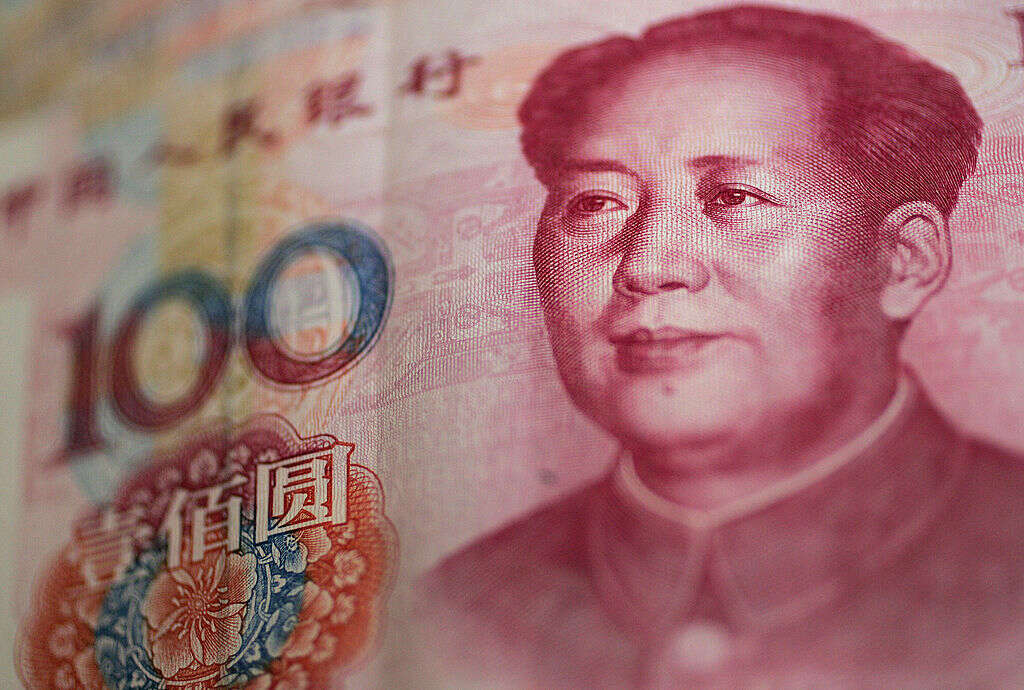
A promotional cartoon for China’s digital yuan shared on state broadcaster CGTN leaves little doubt about the country’s ambitions for its currency. It depicts a person-sized golden yuan bowling over an unsuspecting figure draped in the American flag. China’s internationalist pitch for its central bank digital currency (CBDC) is feeding Western fears it could one day occupy the US dollar’s role in the global economy.

A CBDC is unlike both e-money, which is processed through the regular financial channels and infrastructure, and cryptocurrencies, which are mostly decentralised and untethered to any banking system. To transact in a CBDC, the central bank is the only conduit needed. This means payments are instantaneous and can even be conducted off-line, without the participation of clearing banks and the inefficiencies they introduce.
In the last month, news has emerged that the UK is mulling a CBDC, or “Britcoin”, while the EU said that a digital euro could launch within five years. A recent Bank of International Settlements survey found that 80% of central banks are entertaining the possibility of a CBDC, and 40% have progressed to experiments or proof of concept. But China is outpacing every other major economy. It’s piloting not only domestic payments in digital yuan, but also cross-border transactions in partnership with the central banks of Hong Kong, Thailand and the United Arab Emirates. While Western countries hang back, why is China in such a rush to launch its digital yuan?
When the digital yuan project began in 2014, “the original idea was to try to upgrade the retail payment system,” says Linghao Bao, analyst at Beijing-based policy research agency Trivium China. Digital payments services WeChat and Alipay now make up the vast majority of retail payments in China.
The project was given a boost in 2019, when Facebook announced its own digital currency project Libra (which has since been renamed Diem and is yet to launch). Bao notes that, like other central banks around the world, the People’s Bank of China (PBOC) was shaken by this announcement “because it could potentially erode their monetary sovereignty, it could impact their ability to make monetary policies and basically threaten their monopoly power”.
China’s eagerness to launch the digital yuan is partly due to the promise of greater government oversight into transactions done in its jurisdiction – assisting with China’s constant battle against shadow banking and fraud. There is also a public relations element, where it looks good to be among the first to launch a digital currency, says Maximilian Kärnfelt, analyst at Merics.
But another driver is the possibility that it could transform China’s role and influence within the global financial system. Kärnfelt says that the PBOC is eager to tie plans for financial opening to the digital yuan. “They say that the launch of the digital [yuan] will lead to the renminbi becoming a much more international currency.” (Renminbi is the official name of China’s currency and is used like ‘sterling”, while the yuan is the unit of that currency.)
Where might the digital yuan be used?
China is aiming to drive domestic adoption of the digital yuan first. It has recently been gifting citizens “red envelopes” filled with time-limited digital yuan, to encourage them to spend it. But making the renminbi an international currency is the eventual goal.
At present, the renminbi only accounts for around 2% of global foreign reserves, according to the International Monetary Fund (IMF), and its share of global payments languishes around 1.88%, according to SWIFT, the global provider of secure financial messaging services. But there are hopes that eventually, a digital yuan might help to improve this.
The plan is to drive uptake in Belt and Road countries first, where China is investing in major land, sea and digital infrastructure projects. This will eliminate the necessity for clearing transactions through intermediary banks. As long as two people have smartphones, they will be able to transact with each other. Because of this, the currency should appeal to people in rural parts of developing countries, who may have a phone but not a bank account.
“[Chinese] private-firm-based payment systems are already adopted in Africa and South Asia,” says Will Cong, associate professor of economics at Cornell University. “China’s [digital yuan] could easily expand in this direction. It is for trade, but it is also for international remittance.” He uses the example of Hong Kongers sending money back to China. This is a process that has already been vastly simplified with the advent of WeChat and Alipay, and one that the integration of the digital yuan could simplify further.
Africa is one part of the world where the digital yuan might be used one day. As Tech Monitor has reported, Chinese consumer technology is very popular on the continent, with Chinese smartphones dominating more than half the market share. This could play an important part in encouraging the use of the digital yuan abroad, especially given the latest Huawei phone to launch on the continent comes with an inbuilt digital yuan wallet.
This isn’t hugely important right now, says managing editor of the China Africa Project, Eric Olander, because the phone is expensive and there’s currently no widespread exchanging of yuan among people in Africa. Huawei phones are also becoming less visible in Africa because they no longer use Android OS. But it could be a precursor of things to come. “If Transsion or Xiaomi or any of the other Chinese device makers follow Huawei’s lead then that could be a game changer,” Olander says.
In the near term, the digital yuan could prove appealing to traders who want to reduce the currency conversion fees when doing business with China. Some Nigerian companies currently use Bitcoin to leapfrog trade hurdles with the nation.
At a consumer level, Olander says the renminbi’s lack of convertibility make it less appealing to use than dollars or euros. But the digital yuan might be less about the near-term goals for China, and more about “laying the groundwork for something that’s coming five to ten to fifteen years down the road”.
Could the digital yuan replace the dollar?
There is speculation over whether China is seeking to displace or work around the current US-backed global financial system – as CGTN’s promotional video would suggest. There are particular concerns from the US that digital yuan could help countries evade US sanctions.
“What the US has typically done is pushed Swift and banks very heavily and put penalties on them if they did business with, for example, Iran,” says Kärnfelt. “If things are done in a different clearing system, then the US does not have any oversight over them, and it would be harder for them to apply any financial sanctions.”
Countries under US sanctions already attempt to diversify reserve currencies away from the dollar. According to an IMF report, in the Spring of 2018, the Bank of Russia “implemented a significant reallocation of its reserve portfolio away from the US dollar, mostly into renminbi, following the imposition of US sanctions”, which led to a 26 percentage points decline in dollar share. Some in the US believe the digital yuan would further feed this phenomenon.
But while the digital yuan could be used to get around sanctions, Cong points out that, unlike Bitcoin, it is subject to regulation. “So to the extent that the Chinese government wants to comply with US sanctions in some countries, then [the digital yuan] would not change that.”
There are bigger concerns in the West that the digital yuan could supplant the dollar, and reorder the current global financial system altogether. But these fears are likely to be overstated at present. Data from the IMF shows the US dollar accounted for 59% of global foreign exchange reserves at the end of 2020, which although representing a 25-year low, still puts it far ahead of other currencies.
Kärnfelt says that right now, China’s CNY (renminbi) business is mostly with poorer neighbouring countries. “This is becoming a little bit like a smaller financial system that is less plugged into the global financial system,” he says. “But at the same time, China is opening more pathways for investment into the Chinese system, from the big players in the front end of the global financial system, and that’s happening using the existing infrastructure.”
This is reflected in China reportedly encouraging local and foreign banks to use its Cross-border Interbank Payment System, a competitor to SWIFT (which could increase the ratio of yuan in international transactions), and at the same time announcing new ventures between SWIFT and four Chinese institutions that will provide localised financial services to increase the stability of cross-border transactions.
“Swift, Visa, MasterCard, all of these are setting up joint ventures with Chinese companies in Beijing,” says Kärnfelt. “So as much as China is doing its own thing, it’s also digging itself deeper into the existing structures.”
The limits of the renminbi
The renminbi’s weak starting position also puts it at a disadvantage. Kärnfelt highlights the already vast disparity between the size of China’s economy and the paltry percentage of global transactions using the renminbi. “That has persisted for a very long time so that the reason for the renminbi not being used is older than the digital [yuan].”
Bao points out that becoming an international currency is not just a function of being digital. “In order to be a global reserve currency, you also need a free convertible currency or a lot of capital markets, and China is lagging way behind on these fronts relative to the United States,” he says. “Even [with] the launch of its own national digital currency, it doesn’t necessarily mean that people are going to be more willing to transact in renminbi or invest in renminbi assets.”
Even [with] the launch of its own national digital currency, it doesn’t necessarily mean that people are going to be more willing to transact or invest in the renminbi assets.
Linghao Bao, Trivium China
“Any displacement [of the dollar] would come more from the real economy and development rather than the payment system,” Cong says.
The shifting global economic terrain could help expedite this. The IMF report predicts that China could overtake the US as the world’s biggest economy by 2030, and that the share of EMDEs (Emerging Markets and Developing Economies) in global GDP is expected to increase more than 50% by the same year. It notes that growing financial integration has contributed to global capital flows three times as large in recent years than in 1970s, but says “despite this ongoing shift to a more multipolar global economy, the high degree of inertia in the currency composition of global reserves suggests that the US dollar will remain the dominant reserve currency for the foreseeable future”.
Even so, China being ahead of the curve on digital currency could bring advantages. The IMF report notes that “existing cross-border transfer and payment systems face multiple legacy issues”, and can be “complex, slow, expensive, and non-transparent”. It says that although Swift and legacy settlement systems run by central banks are updating their technology to boost transparency, interoperability and speed, these measures only “offer partial solutions by integrating recent technologies into existing infrastructure”.
The report lays out one potential scenario for the future of money, where a bloc of savvy countries issues a CBDC and invests heavily in data infrastructure and cyber defence, generating a growing supply of the CBDC-denominated financial instruments. “The CBDC – seen as a trustworthy and credible reserve currency because it provides safety and access and is backed by high-tech secure platforms with low transaction costs – emerges as a major reserve currency. With central banks around the world holding more of the new CBDC, its share in global reserves rises well above the levels consistent with the size and fiscal backing of the economic bloc.” Could the digital yuan become such a CBDC?






